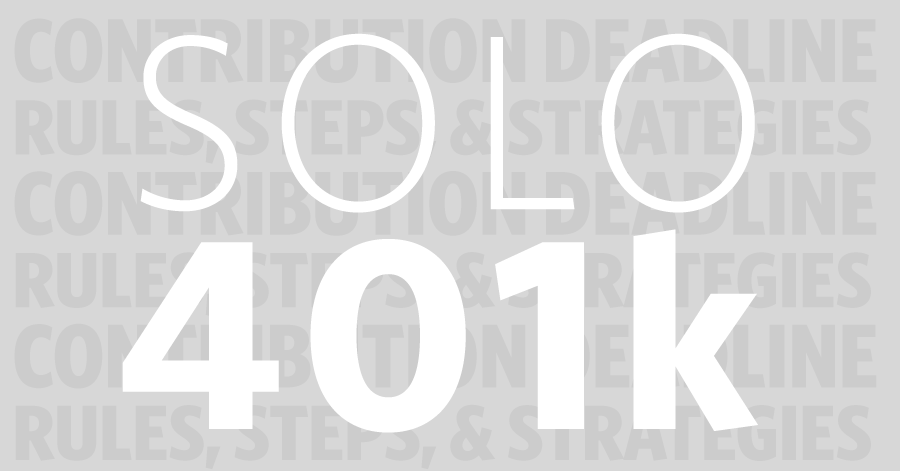As 2021 has come to an end, it is critical that Solo 401(k) owners understand when and how to make their 2021 contributions. There are three important deadlines you must know if you have a Solo 401(k) or if you plan to set one up still for 2021. A Solo 401(k) is a retirement plan for small business owners or self-employed persons who have no other full-time employees other than partners or a spouse. It can be fully self-directed into real estate, LLCs, private funds, cryptocurrency, or other alternative investments, and allows the owner/participants to contribute up to $58,000 per year (far more than any IRA). For 2021 contributions, the employee maximum is $19,500, and the employer’s maximum is $38,500 for a total of $58,000., The limits for 2022 increase to $61,000.
2021 Contributions Can Be Made in 2022
Both employee and employer contributions can be made up until the company’s tax return deadline including extensions. If you have a sole proprietorship (e.g. single-member LLC or schedule C income) or C-Corporation, then the company tax return deadline is April 18th, 2022. If you have an S-Corporation or partnership LLC, the deadline for 2021 contributions is March 15th, 2022. Both deadlines (March 15th and April 18th) to make 2021 contributions may be extended another six months by filing an extension. This is a huge benefit for those that want to make 2021 contributions but who won’t have funds until later in the year to do so.
W-2’s And Employee Deferrals Force You to Plan Now
While employee and employer contributions may be extended until the company tax return deadline, you will typically need to file a W-2 for your wages (e.g. an S-Corporation) by January 31st, 2022. The W-2 will include your wage income and any deduction for employee retirement plan contributions will be reduced on the W-2 in box 12. As a result, you should make your employee contributions (up to $19,500 for 2021) by January 31st, 2022 or you should at least determine the amount you plan to contribute so that you can file an accurate W-2 by January 31st, 2022. If you don’t have all or a portion of the funds you plan to contribute available by the time your W-2 is due, you can set the amount you plan to contribute to the 401(k) as an employee contribution, and will then need to make said contribution by the tax return deadline (including extensions).
Example
Now let’s bring this all together and look at an example outlining how this may work. Sally is 44 years old and has an S-Corporation for her online business. She is the sole owner and only employee and had a new Solo 401(k) established in 2021. She has $120,000 in net income for the year and will have taken $50,000 of that in wage income that will go on her W-2 for the year. That will leave $70,000 of profit that is taxable to her and that will come through to her personally via a K-1 from the business. Sally has not yet made any 2021 401(k) contributions but plans to do so in order to reduce her taxable income for the year and to build a nest egg for retirement. If she decided to max-out her 2021 Solo 401(k) contributions, it would look like this:
-
- Employee Contributions – The 2021 maximum employee contribution is $19,500. This is dollar for dollar on wages so she can contribute $19,500 as long as she made $19,500. Since Sally has $50,000 in wages from her S-Corp, she can easily make a $19,500 employee contribution. Let’s say that Sally doesn’t have the $19,500 to contribute, but will have it available by the tax return deadline (including extensions). What Sally will need to do is let her accountant or payroll company know what she plans to contribute as an employee contribution so that they can properly report the contributions on her payroll and W-2 reporting. By making a $19,500 employee contribution, Sally has reduced her taxable income on her W-2 from $50,000 to $30,500. This assumes she made a traditional contribution. Roth employee contributions would not reduce the taxable income on the W-2. At even a 30% tax bracket for federal taxes and a 5% tax bracket for state taxes that comes to a tax savings of $6,825.
- Employer Contributions – The 2021 maximum employer contribution is 25% of wage compensation not to exceed $58,000 in total. Since Sally has taken a W-2 wage of $50,000, the company may make an employer contribution of $12,500 (25% of $50,000). This contribution is an expense to the company and is included as an employee benefit expense on the S-Corporation’s tax return (form 1120S). In the stated example, Sally would’ve had $70,000 in net profit/income from the company before making the Solo 401(k) contribution. After making the employer matching contribution of $12,500 in this example, Sally would then only receive a K-1 and net income/profit from the S-Corporation of $58,000. Again, if she were in a 30% federal and a 5% state tax bracket, that would create a tax savings of $4,375. This employer contribution would need to be made by March 15th, 2022 (the company return deadline) or by September 15th, 2022 if the company were to file an extension. In the end, Sally would have contributed and saved $32,000 for retirement ($19,500 employee contribution, $12,500 employer contribution). And she would have saved approximately $11,200 in federal and state taxes. That’s a win-win.
Keep in mind, you need to start making plans now, and begin coordinating with your accountant or payroll company as your yearly wage information on your W-2 (self-employment income for sole props) is critical in determining what you can contribute to your Solo 401(k).
Solo 401(k) Plan Set-Up Deadlines to Make Contributions for 2021
In order to make the full 2021 contribution of $58,000 to your solo(k), you must have had your plan established n by December 31, 2021, and ensure your Employee Contribution is reported on form W-2 which is due January 31st, 2022. The total $58,000 contribution limit consists of $19,500 in employee contributions and $38,500 in employer contributions. If you do not have the plan set-up by December 31, 2021, and your Employee Contribution reported on the W-2 is due in January, you cannot make employee contributions as you weren’t able to elect an employee deferral in 2021.
You can set up your solo 401(k) after December 31, 2021, and still make 2021 employer contributions. The Secure Act, which went into law in 2019, allows you to set up your solo 401(k) by the adopting employer’s tax filing deadline and still make your employer contribution. This timeline includes extensions. So, if you set up your solo 401(k) plan on February 1, 2022, you can still make your employer contributions, which could be up to as much as $38,500 depending on your wage or self-employment income. Also, if you extended your 2021 business return from March 15th to September 15th your deadline to establish a new solo 401(k) plan and to make 2021 employer contributions is September 15, 2022.
Keep in mind that while IRAs can be established until April 15th, 2022 for 2021 contributions (extended by the IRS to May 16, 2022, for Colorado Residents Only), a solo 401(k) should be established by December 31st, 2021 if you want to make both employee and employer contributions for 2021. Don’t get the IRA and solo 401(k) deadlines confused and make sure you’ve got a plan for your specific business.
We can help in establishing your solo(k) at KKOS Lawyers using our IRS pre-approved solo(k) plan documents where you can self-direct the solo(k) and have checkbook control right out of the plan. We handle statements and reporting as well as IRS-required plan document updates for your solo 401(k) at Directed Trust Company.
Click here to learn more about setting up a Solo 401k at Directed Trust Company.

